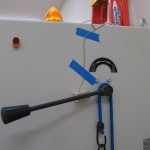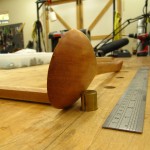I love bandsaws. They are extremely useful tools and probably the safest powered woodworking tool in the shop. However, there are some nagging features that are common among most bandsaws on the market (except very expensive, feature rich saws) – they require manually tensioning and untensioning the blade.
A bandsaw has a long single loop blade (on my saws the lengths range from 71″ to 140″) which is suspended between two wheels – the driving wheel and the idler wheel. These wheels have rubber (or urethane) covers to cushion and provide a friction surface for the blade. Unfortunately, if you leave a blade under tension, the rubber gets flattened on one half of it’s circumference – the side under tension and the blade tends to stretch. Conversely, if you leave the blade untensioned and forget to tension it prior to turning on the saw, you will receive a nasty surprise. If you’re lucky, the only thing that will happen is that the blade will jump off the wheels and only ruin the blade. If you’re unlucky then YOU might get ‘ruined’ along with the blade.
There is one other aspect of bandsaw safety that most other high power woodworking tools have already addressed – the switches used to turn on bandsaws are simply On/Off switches – you turn it on, it stays on until you manually turn it off. Other high power equipment has a ‘magnetic’ switch, which will turn on ONLY if there is power and, if power is lost, then the magnetic switch automatically turns off.
Why does this matter? If you live in an area that occasionally loses power (the House in the Woods, for a random example – thanks ‘Progress’ Energy) then you will find that it is very disconcerting to come back to your shop only to find a piece of equipment was accidentally left on during the last power outage. Again, if you’re lucky then you’ve only wasted some power and a bit of wear and tear on your equipment. I won’t speculate on the ‘unlucky’ scenario.
So, given this introduction, I’ve upgraded my two bandsaws with Safety switches. What do they do, you ask?
First, they are magnetic switches which WILL automatically turn off if we lose power. – Check!
Second, they have an interlock that will prevent the saw from turning on if the Blade is untensioned! Cool, Double Check!
Thirdly, they will light a very noticeable light when the blade is tensioned. This reminds me to untension the blade when I’m shutting down at the end of a session. Excellent! Triple Check!
Here are a couple of views on one bandsaw’s upgrade…
-

-
Bandsaw with new, rather Industrial looking Magnetic Switch. Notice the light above the saw – the blade is tensioned!
-

-
Here is the tension control activated. The light is on! PS: The blue tape is temporary…
-

-
The tension control is off. Note the custom holder for the magnetic sensor controlling the switch.







